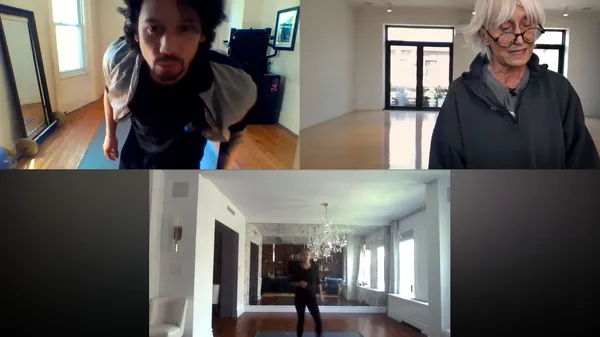 |
| Twyla Tharp on Zoom with Herman Cornejo and Misty Copeland in Steven Cantor’s Twyla Moves Photo: Zoom Stick Figure Films |
Steven Cantor’s intimate and fierce Twyla Moves showcases the legendary Twyla Tharp working on a Zoom dance from New York during the height of the pandemic with Misty Copeland, Benjamin Buza, Herman Cornejo, Maria Khoreva, Kaitlyn Gilliland, and Charlie Neshyba-Hodges in other locations. She invites the great production designer Santo Loquasto to have a look. Twyla has collaborated with composers Philip Glass, David Byrne, David Van Tieghem, and Glenn Branca, won the Tony Award for Best Choreography for Movin’ Out, featuring the songs of Billy Joel, staged dances for Miloš Forman’s Hair, Ragtime, and Amadeus, and Mikhail Baryshnikov and Gregory Hines in Taylor Hackford’s White Nights.
Dancer, featuring Sergei Polunin, and Tyler Peck’s Ballet Now round out Steven’s trilogy of dance films.
From New York, Steven Cantor joined me on Zoom for an in-depth conversation on Twyla Moves.
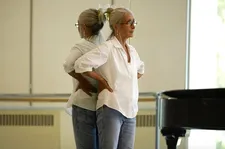 |
| Steven Cantor on Twyla Tharp: “She wakes up every day, seven days a week and wants to make dance …” Photo: Twyla Tharp Foundation |
Anne-Katrin Titze: We met nearly five years ago with SergeI [Polunin]. How is he doing?
Steven Cantor: He’s okay, he’s still hanging in there. He’s had a son.
AKT: I actually stumbled upon your Twyla Moves when I was watching Hemingway.
SC: How funny.
AKT: I really liked the structuring of your film around Central Park, which reappears three times. First her rehearsals and performances in Central Park. Then in the middle part …
SC: … Hair!
AKT: Yes, and in the end she is walking in winter with her son Jesse. So Central Park was your structuring device?
SC: Interesting! You’re the first person who’s noticed that, so good job! You’re right we did talk about that once in each act. I think the structuring device was more chronological. It was two stories, a present day story where she’s creating this piece and then the archival where we pretty much went in chronological order. It was more structured around story elements but there’s definitely a park theme. Central Park was definitely the one place she goes outside, has a walk and finds a little peace with the stressful situation.
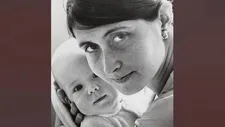 |
| Twyla Tharp with her son Jesse Photo: James Klosty |
AKT: How much were you with her? Was a lot of it done remotely?
SC: No, we were together. We decided last March we were going to be in each other’s pod and spent the whole year together for the most part.
AKT: The very last time I was at the World Trade Center Twin Towers was on September 8, 2001 for a performance of Twyla Tharp Excerpts from the Sinatra Suite. The memories are so connected for me.
SC: I didn’t even know that. Interesting.
AKT: There were dance performances going on on that plaza the week before 9/11. It was very powerful. So for me she is really connected to the city, maybe that’s why I noticed the park.
SC: It’s right outside her window. She has her studio right at the park on 94th Street.
AKT: Tell me a bit about your choices of which pieces to include, which not to include in Twyla Moves? Did you decide with her or was it mostly your choice?
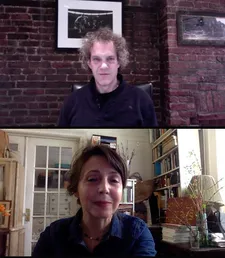 |
| Steven Cantor with Anne-Katrin Titze on Central Park being a structural device for Twyla Moves: “You’re right, we did talk about that once in each act.” |
SC: It was with her. I actually included her in that part of the process from the beginning. I knew it was going to be unbelievably painful for someone who had made - basically she has 200 babies and she has to choose very few of them to be highlighted. Some of them had to be included. We weren’t going to make a Twyla movie without Baryshnikov or Movin’ Out or Hair. It was certain tent-pole pieces, so that did not leave too much room for the other ones. It’s basically the low hanging fruit, the best-known, not necessarily the ones that she thought were the best, or that necessarily had the best video archives. It was really the ones that made the most noise were the ones that we gravitated towards.
AKT: It didn’t feel like what you call the “low hanging fruit.” Maybe because of my name and a driving for perfection, I was glad to see Catherine Wheel included.
SC: Yeah, well, Catherine Wheel with David Byrne.
AKT: I liked when David Byrne expresses how much Twyla pushed him. How the Catherine Wheel was spinning in his direction. Nobody pushed him that way before. That’s great footage.
SC: Yeah, she’s fierce. Nobody gets in her way. When she takes something on, she’s in charge. If you get in her way, you’re getting steamrolled.
AKT: Were you steamrolled sometimes?
SC: Yeah. I love her and we had a great relationship. Exactly what you’re talking about, was unbelievably hard for her, to choose the pieces. I had ones that I loved. One of my favorite parts of the film is that banjo solo and she was like, “that’s just a little trifle thing I put together over a couple of days.” I thought just hearing her explain exactly what the dance is going to be, what the steps are going to be, it’s kind of funny and powerful. It felt a little bit like a TikTok thing or something. And then you see her do it in double speed. I felt it kind of lent a language to her artistry. Just seeing the artistry was hard to grasp. She definitely fought me on a lot of things and won some things and lost some things. She really wanted the film to just focus on her work. I had to push to include more of the personal story. She didn’t want her son [Jesse] to have to get involved.
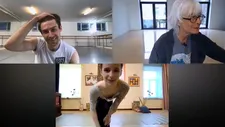 |
| Twyla Tharp with Benjamin Buza and Maria Khoreva Photo: Zoom Stick Figure Films |
AKT: Did he want to get involved?
SC: I think so. I think he had a lot of things to say, both to her and as a cathartic experience for himself to get it off his chest. I think the film gave him a little outlet for that.
AKT: It feels like that. He gets to express himself when they are walking through the park. In Dancer and some of your other work, childhood is something you like to include, isn’t it?
SC: It’s funny, in those two, yeah. I guess I do a lot of profiles of people that are successful, particularly arts, lately, I guess I’m always interested in the formative years experience. How they got shaped to become that way. Usually there’s some form of trauma or stress. You rarely have someone who’s just from a happy nuclear family and everything is great and then they decide to become an artist and all of a sudden they’re Twyla Tharp or Beethoven, or whatever.
AKT: And then with the children of those famous artists - although I couldn’t tell you anything about Beethoven’s - there is another toll to pay, another turn of the screw of fame.
SC: Also very very successful people tend to be myopically focused on their career at the expense of everything else. And Twyla is a shining example of that. She just wanted to make dance. She wakes up every day, seven days a week and wants to make dance and that’s it. Nothing else gets in the way, no relationships, no travel, no vacation, no kids, no nothing.
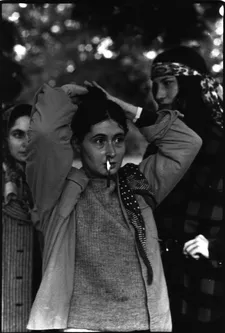 |
| Twyla Tharp putting her hair up with dancers in Central Park during the filming of Miloš Forman’s Hair Photo: Herbert Migdoll |
AKT: How do you make dance during a pandemic? How to make that work is her main concern.
SC: Yeah.
AKT: I liked that you included Santo Loquasto, one of the great production designers. That he appeared. He didn’t really have to say very much, he didn’t transform what’s going on, but confirmed that it’s actually best to look provisional. Was that your idea to have him come?
SC: They have a long-standing relationship and have done a ton of pieces together. He’s been her go-to designer on everything. She trusts his opinion a lot and she was very uncertain about this Zoom piece. She hadn’t done anything where she couldn’t touch the dancers and couldn’t be in-person with them. I think, we were thinking that he was going to come in and help us take this thing. It was just a shell of an idea and gritty and Misty Copeland gets replaced by Charlie Hodges. And everyone’s changing clothes and there’s time lags and all kinds of problems.
And he was going to come in and help us figure out how to make it uniform. Do we shoot all with everybody against white? How are we going to get costumes and make this feel like it’s got a flow to it? We thought he was going to come in and be that guy. I think he came in expecting to be that guy, expecting to give it a shape. And he walks in and he just thought on its own, in its gritty, real, natural form was just a great testament of what we’ve all gone through, and worked on the dance without being shiny and slick. So that was a blessing. I think when he said that it resonated with her.
AKT: It shows the little delays on Zoom and how we are all getting used to fine shifts in communication - through dance. We don’t see the whole piece in the end?
SC: You see most of it through Santo’s eyes. We’re still figuring out what it’s going to be. She’s actually doing a little piece at the Joyce [Theater in NYC on April 26].
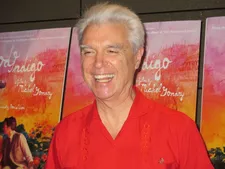 |
| David Byrne in Twyla Moves notes how much Twyla pushed him. How the Catherine Wheel was spinning in his direction. Photo: Anne-Katrin Titze |
AKT: It hasn’t been finished yet?
SC: It isn’t finished and hasn’t been out there yet, yeah. The most amazing thing was to see her work, when they were actually all four on the screen trying to do it together. It took an hour to figure it out and there was no way to show it really in the film. So you just get the briefest little moment. She was like: “ Okay Maria [Khoreva], you are going to dance one and a half beats behind the music, Misty, you’re going to dance right on the music, Herman [Cornejo], you’re going to be a beat and a half ahead, and Charlie, one beat back, Maria one beat forward…” And they were dancing off the music and she was getting everyone in sync, it was amazing.
AKT: And with Zoom, it’s never the same, so it would all shift again for a live performance. Will there ever be a live performance?
SC: I don’t think so. Only on Zoom.
AKT: And she is using the very old structure of a tale for it.
SC: I told her in the beginning that she can do anything she wants, I don’t care if it’s on Broadway. I don’t care if it’s live, not live, in a theatre, a small piece, a big piece, two dancers, ten dancers - I just wanted to hear her language and see the way she works with dancers. Just understand her mechanics how she puts together a piece. I think we really got that. You really see her testing it out on herself, going through the moves herself and then teaching it to the dancers. I like what Herman says, she does it herself and then you do it and you’re like, oh, my back! She’s an amazing dancer.
 |
| Joyce Theater Foundation Virtual Benefit featuring Twyla Tharp with Misty Copeland and Herman Cornejo |
AKT: The replacement of Misty Copeland also tells us so much. She doesn’t go for someone similar. She picks someone else entirely. And then you get a different identity and movement.
SC: Yeah.
AKT: One of the dances my spouse [Ed Bahlman] was waiting for was Fait Accompli. You showed no clips from it.
SC: She didn’t have any great recording, any great footage of it. It’s hard to shoot dance, because there’s union issues. A lot of times they just prop a camera up in the back or not even. So he loves Fait Accompli?
AKT: It’s forever in his memory.
SC: Is he a big dance fan?
AKT: He is. The other thing, Glenn Branca’s Bad Smells you were using. He actually produced the first two records of Glenn Branca.
SC: Oh wow! Interesting. That’s why we had to have a list of all her works. You see so many extra dances at the end. It was impossible.
AKT: He is going to enter the screen!
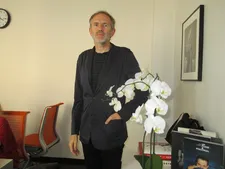 |
| Steven Cantor lets on that Anton Corbijn will be directing Satori and he will be producing. Photo: Anne-Katrin Titze |
Ed Bahlman: Hi Steven!
SC: Nice to meet you.
EB: I founded 99 Records.
SC: Oh wow.
EB: Lesson No 1 and the Ascension album.
SC: Wow.
EB: Also David Van Tieghem brought by a cassette tape before he presented it to Twyla Tharp of Fait Accompli. And he asked what I thought and I said this is great. I went to the [Brooklyn Academy of Music] Opera House for the rehearsal.
SC: Fascinating. Great career.
AKT: That’s the advantage of Zoom, we can have guests. Did you see the Hemingway, by the way?
SC: Yes I did.
AKT: Did you like it?
SC: Yeah. There was some cool stuff I had never seen.
AKT: I liked the things about his childhood. I hate all kinds of bullfighting.
 |
| Glenn Branca The Ascension (99 Records - 99-001LP) produced by Ed Bahlman LP album cover designed by Robert Longo Photo: Anne-Katrin Titze |
SC: Yeah, me too. Have you ever seen the film [Ballet Now] I made on Tyler Peck?
AKT: No, do you have a link?
SC: I’ll send it to you right now! It felt like this was my third and final dance film. Dancer, female dancer, and Twyla, that’s it.
AKT: What’s going on with Satori? You mentioned that Anton Corbijn is involved.
SC: Yeah, Anton is directing it. I was done.
AKT: You’re no longer producing?
SC: No, we’re producing it. I didn’t want to make Dancer II. I felt it needed to be just visual, take it out of the realm of documentary. You know, he got a Putin tattoo and had a kid and all that stuff.
AKT: He got what?
SC: A Putin tattoo on his chest. He had it removed now. That was a big story. He made some comments on social media that were perceived as being homophobic. He’s not homophobic but the whole dance world came down on him and people stopped following him. The whole documentary story was like, I had spent years with the guy making Dancer, I don’t want to spend any more time on a sequel to a doc.
AKT: And now Anton is turning this into what?
SC: He [Sergei] made a music video to a Depeche Mode song and it’ll be some of the making of that. It’ll be a lot of dancing. Probably closer to something like Pina.
AKT: Wim Wenders’ Pina?
SC: Yeah. I don’t know if it’s going to be 3-D or what. We’re still figuring it out.
AKT: What’s coming up for you next?
SC: I just finished a movie [Hood River] about a boy’s high school soccer team in Oregon that’s half Mexican and half white. And the Mexican’s parents work on the white people’s properties. Robert Rodriguez, Cristina Patwa, that’s going to HBO right now. And we just sold an Arthur Ashe film to CNN. We’re doing a Misty film but I’m not directing it. And we have a bunch of series in the works, we’re busy.
AKT: Thank you!
SC: I’ll send you the Tyler film. Good to talk to you! Thanks for being in touch.





















